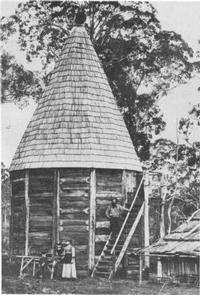


Chapter 6
I Construction During The Settlement Years
II The Use Of Timber As A Structural Material
III Structural Steel
IV Concrete Technology
V Housing
VI Industrialised Pre-cast Concrete Housing
VII Ports And Harbours
VIII Roads
IX Heavy Foundations
X Bridges
XI Sewerage
XII Water Engineering
XIII Railways
XIV Major Buildings
XV Airports
XVI Thermal Power Stations
XVII Materials Handling
XVIII Oil Industry
XIX The Snowy Mountains Scheme
XX The Sydney Opera House
XXI The Sydney Harbour Bridge
XXII Hamersley Iron
XXIII North West Shelf
Sources and References
Index
Search
Help
Contact us

What Hoddle contributed to Melbourne, Colonel Light did to Adelaide. His early work was marked by controversy, indeed Governor Hindmarsh, when arriving on 18th December, 1836, expressed his displeasure at the site chosen by Light for the new city. His principal objection was the distance of the city from the port, but reason prevailed and Light and his staff produced a plan of such quality that it was regarded as a model for others to follow.
The first Australian buildings were simple structures, square posts set into the ground around wall lines, tied by sawn plates, on which were erected roof structures fabricated from unsawn saplings. Walls consisted structurally of short saplings with shaped ends, which were fitted into slots in the posts. Protection from the elements was achieved by a spade-applied heavy coating of mud. This in turn was protected by a coating of readily available pipe-clay and/or whitewashed with a lime made by burning oyster shells collected by convict women. Doors were simple ledge and brace construction, hung on leather hinges. Chimneys were constructed from timber heavily parged with clay, while floors were packed earth or clay (Fig. 2).

The custom of beer drinking spread to the Colony in early days. It led to the establishment of the first hop kilns, which were built in similar style to the early buildings. Fig. 3 illustrates the type of construction, with a shingle roof, and the adjacent building to the kiln illustrates the verticle slab type construction with primitive bark roof.

A stable and safe water supply stream is fundamental for the development of any permanent settlement. It was for this reason that Captain Phillip decided on Sydney Cove, Port Jackson instead of Botany Bay as a permanent site for settlement. Port Jackson, he said, had 'the finest spring water' and it became known as the Tank Stream.
The Tank Stream supply was augmented by wells cut in the sandstone and by water drawn from Lachlan Swamps. It served the community well enough, but the indiscretions of the population caused so much pollution that it was abandoned in 1826. As the settlement grew, the increasing demand for water, and the pollution of the Tank Stream, led to the execution of the first major underground engineering project in Australia -the tunnel, or 'Busby's Bore', which was built to carry water from Lachlan Swamps to a reservoir in Hyde Park. The engineer responsible, John Busby, was appointed to New South Wales as Minerals Surveyor and Civil Engineer at a salary of £1200 p.a. The Tank Stream ultimately served as an open sewer, but in due course pestilence and disease forced the diversion of wastes from open polluted streams to five main underground brick outfall sewers which had been completed in 1857.
People in Bright Sparcs - Busby, John; Holland, Sir John; Light, Col. William
 |
Australian Academy of Technological Sciences and Engineering |  |
© 1988 Print Edition pages 314 - 315, Online Edition 2000
Published by Australian Science and Technology Heritage Centre, using the Web Academic Resource Publisher
http://www.austehc.unimelb.edu.au/tia/314.html